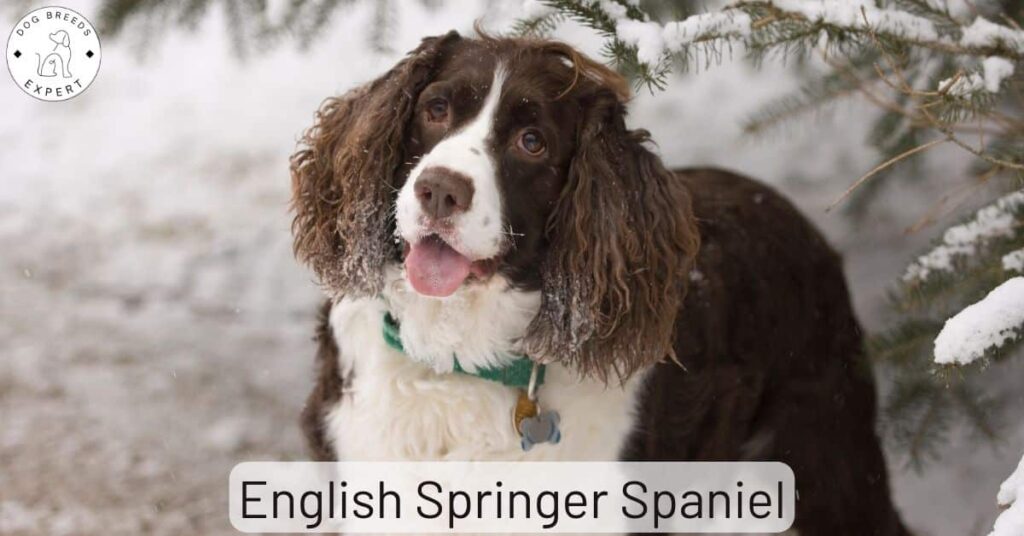Intelligent, Affectionate, Playful
The English Springer Spaniel is an affectionate, sociable companion that can also serve as a working dog. The breed is well known for being smart.
These dogs are also known for their playfulness, making for a great family pet. Guests love these dogs for the warm welcome they provide upon entering a home.
These dogs are popular for their very social personalities. Springer Spaniels are hardly suspicious of strangers or new people in the house, and will approach them warmly.
They will welcome guests enthusiastically, especially if they are given some attention..

English Springer Spaniel – Temperament
These dogs are so social that they hate being left alone. Springer Spaniels are, unfortunately, a bit dependent on human company. If left alone for too long, they may indulge in some destructive behavior.
They are also known to bark often when alone, so these are not great dogs for owners who are not home all day.
The English Springer Spaniel is undoubtedly a family dog. The more people for it to play with, the better.
They are the right size to be able to play with children without a high risk of injuring them. Their energy and playfulness are especially appreciated amongst kids, but they should always be monitored when playing with small children.

Their social nature does not stop with their two-legged friends. They are just as friendly with other canines and pets.
They are ideal dogs for sharing the house with other pets, and will enjoy the additional company. Other dogs in the house will also keep the Spaniel busy when left alone.
The English Springer Spaniel was used as a hunting dog, and many of its hunting dog instincts hold true to this day.
These dogs have a tendency to chase after the small game that may wander onto the property.
To keep them from chasing a squirrel into traffic, it is recommended that they have some sort of enclosure when outside. They are not very large, or very impressive escape artists, so using an invisible fence can work too.
Did You Know? While traditionally used for hunting, their keen sense of smell is now employed to sniff out drugs, explosives, money, and even people.
Some dogs are more talkative than others, and these Springer Spaniels are a prime example.
They like to bark often, whether it be at a passerby, a rabbit, or an unusual sound. These barks are hardly issued as a warning, but more of a curious response.
Their vocal personalities make them not great dogs for apartments, or for people who are or have neighbors sensitive to volumes.
Springer Spaniels are notoriously dependent on the human company. They hang on every word and take it especially hard when they are scolded.
This breed is known for being a bit sensitive, and this should be taken into consideration when training them. They are not very sensitive to temperatures, however, and are capable of living in many climates.
Springer Spaniels were used as hunting dogs, so they have plenty of energy to be used. They also need a lot of exercise, as they were used to working rigorously.
Regular daily exercise will help consume some of their energy level and keep them healthy. They also enjoy splashing in a pond or stream and playing fetch.
English Springer Spaniel – Breed History

The first clues as to the origins of the English Springer Spaniel can be found in its name. The name Spaniel suggests origins in Spain, although it is most likely that these dogs had been used for hunting long before that. It’s possible that they have around since the time of the Roman Empire.
While they are considered to have originated in Spain, they definitely did not stay too long. The Romans most likely helped distribute this breed throughout their empire, giving it strong roots in Europe.
These dogs would often be used to help flush game out of hiding so that they could be caught by their owners. Their role as such became much more prominent after the invention of the gun.
The earliest depictions of dogs similar to the English Springer Spaniel that we are familiar with emerged in the 16th and 17th centuries.
They are often thought to have been referred to in Welsh laws around 300 A.D. and had been talked about in books during the late 14th century. These dogs would later split into the English Springer and Cocker Spaniels.
Towards the end of the 18th century, there had been widespread agreement to separate the smaller, less heavy Spaniels from their heavier, taller, more athletic counterparts.
The smaller dogs fared better when hunting small game, like Woodcocks, so they were referred to as Cockers. The larger, more athletic ones were referred to as English or Field Spaniels.
Apparently, the Springer Spaniel did not stay only in Europe and Asia. The breed is thought to have made its first appearance in the Western Hemisphere in the early 1900’s in Canada. In a couple years, Springers would be notable as one of the most popular dogs in the US. Even to this day, it remains a popular breed in the country.
WWI put the dog breeding scene on standby. The priority was winning the war, not breeding dogs. Many breeds saw their populations decrease as a result while some even went extinct.
Dog showing somewhat resumed in the few years before WWII, but would not be back in strength for a while.
WWII was the same story. As the entire world was ravaged by the war, so were many dog breeds.
During these wars, however, many breeds found refuge in the US. The post-war US economy paired with the introduction of many new breeds to the country could not have been better. People now could afford luxuries, such as owning a dog, and had quite a selection too.
Today, the English Springer Spaniel holds the ranking as the 28th most popular dog in the US. In the UK, however, they are held with an even higher regard, as the 3rd most popular dog breed registered.
These dogs were first recorded by the AKC in 1910, 7 years after they were registered by the English Kennel Club in 1903.
Ease of Training

The English Springer Spaniel is well known for its ease of training. These dogs are social, intelligent, and eager to please their owners.
Their dependence on human company makes them even less likely to be stubborn or inattentive. The breed is sensitive, although, and the recommended route for training them is through consistent positive reinforcement.
Harsh reprimands for bad behavior will make them reluctant to learn.
Socialization and early exposure are important parts of training any dog breed. It is recommended that dogs are taken on frequent walks and to obedience classes so that is socialized with other canines.
Walking a dog is also a good way to expose it to many sights, smells, and sounds. An exposed and socialized dog will be more relaxed and less vocal.
Owners do not often have to spend much time teaching these dogs how to act around guests, as they typically well behave.
Their frequent barking can be a bit of a nuisance, however, so sometimes owners will teach their dogs to quiet down on command.
It is recommended that these dogs don’t live in areas of high population density, whether it be wildlife or people, as it just gives them more to bark at and worry about.
Vital Statistics
Average Height: 17-20 in. (46-51 cm)
Average Weight: 35-55 lbs. (23-25 kg)
Average Lifespan: 10-15 Years
Colors
There are 6 coat colors registered by the AKC for this breed:
- Liver, White, and Tan
- Black and White
- Black, White, and Tan
- White and Black
- Liver and White
- White and Liver
There are no markings registered by the AKC for this breed.
Grooming the English Springer Spaniel
Altogether, the English Springer Spaniel is not a difficult dog to groom. Their double layered coat sheds regularly year long, however, and must be regularly maintained. Their love of the outdoors means that their coat gets dirty or muddy quickly.
Their coats need to be brushed out 2-3 times a week. Regular brushing will remove shed hair and dirty hair, taking bad odors with them. They aren’t very dirty dogs, but should be bathed every 2-3 weeks, or as needed.
These Springer Spaniels need to have their teeth maintained along with their coat. It’s just as important to provide a dog with proper dental care, as it is to provide it with good healthcare.
Regular brushing will remove plaque, prevent tartar from building up, and help freshen up a dog’s breath. It’s recommended that they have their teeth brushed 2-3 times a week.
It is important to make sure that a Springer Spaniel’s nails don’t get to be too long. If a dog’s nails get too long, they may become irritating. A good way to tell when a dog’s nails are too long is by listening for their nails clicking against the ground at they move. They will typically need their nails clipped every 2 or 3 weeks.
These dogs are known for their low hanging ears, which are great at holding onto dirt and bacteria.
Pay particular attention to all that hair on their ears and behind the ears as that long feathering can get matted quickly. It’s important to clean and check inside the dog’s ears weekly to keep them healthy.
Cleaning their ears once a week will remove built up wax and bacteria, helping prevent ear infections.
Owners will often take their Spaniels to professional groomers to trim their coats and groom them to a higher standard.
This the best video I found that describes the breed the best. Enjoy!
Protection
An English Springer Spaniel is not the best way to defend yourself. It won’t be doing much better defending your family or your property either.
These dogs are known for their athletic build, but not their strength. They are not capable of fending off intruders and are not very intimidating either.
This breed is notoriously vocal, and typically that would make for an ideal watch dog. Unfortunately, Springer Spaniels are not recommended watchdogs either. This is because when they do bark, they often stop soon after, and bark at what alerts them, which isn’t always intruders.
Springer Spaniels don’t have the mindset to be protective dogs. Being working dogs, they have the ability to do the job, it just does not suit them.
They are social and playful, making them more likely to greet an intruder than attempt to stop them. They are not aggressive and not very defensive of their owners either, so they shouldn’t be made to be.
Health Considerations
Dogs, like people, get sick. When you are planning on getting a dog, you have to be prepared for it to have health issues too. Some breeds are more prone to certain health conditions than others are.
While the English Springer Spaniel is typically a pretty healthy dog, it is more prone to certain problems with its health than others.
The following list of health issues has been identified in the breed. It isn’t inevitable that these dogs will be affected by any of these but better safe than sorry:
- Phosphofructokinase Deficiency
- Progressive Retinal Atrophy
- Hip Dysplasia
- Skin Problems
- Entropion
- Ear Infections
Given that this is such a popular breed, it is especially important to find a good breeder when buying an English Springer Spaniel. Be sure to let the breeder know whether you are looking for a working dog or a show dog.
A good breeder will be able to pass health checks for their dogs, be extremely knowledgeable about the breed.
Famous Springers
Buster- Recipient of the Dicken Medal
Jim- Best in Show at the Westminster Dog Show, 2007
Millie- Barbara Bush’s Springer Spaniel



